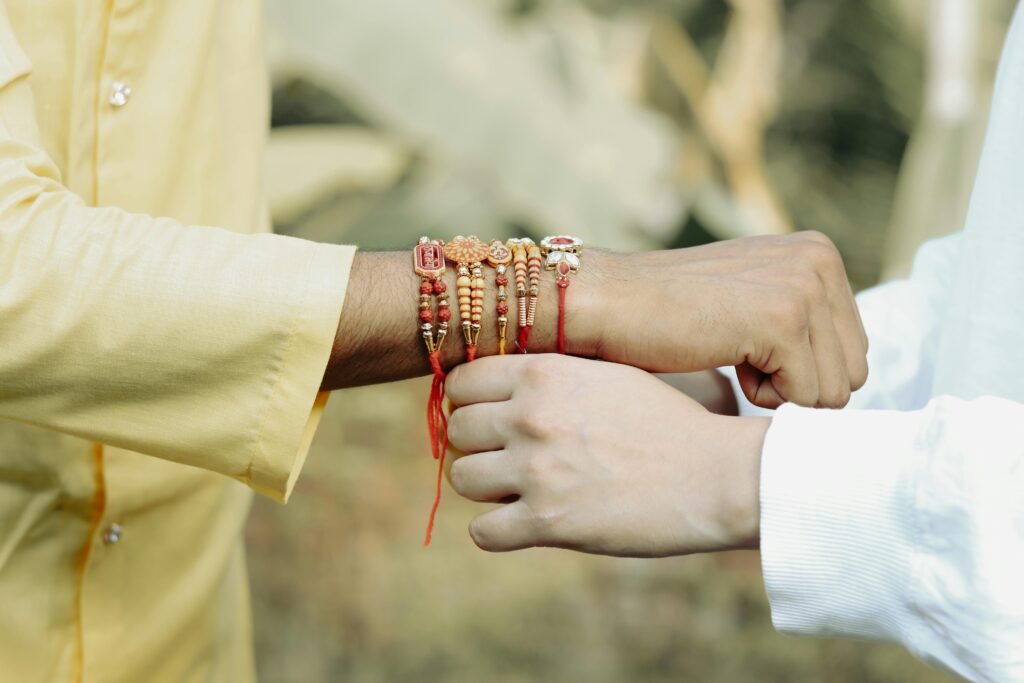Introduction
India is a land of festivals, each rooted in deep cultural values and traditions. Among these, Raksha Bandhan—popularly known as Rakhi—stands out as a beautiful celebration of the sacred bond between brothers and sisters. Observed in the month of Shravana (July-August), this festival transcends mere rituals and becomes an emotional, heartfelt expression of love, protection, and unity.
In 2025, Raksha Bandhan falls on August 18, and families across the country are already preparing to mark this special occasion with joy and devotion. In this blog post, we explore the origin, rituals, significance, and modern-day meaning of Rakhi, offering insights that connect the past with the present.
The Meaning of Raksha Bandhan
The term “Raksha Bandhan” is derived from two Sanskrit words:
- Raksha, meaning protection
- Bandhan, meaning bond or tie
Together, it symbolizes the promise of protection made by a brother to his sister. In return, the sister ties a Rakhi—a sacred thread—on her brother’s wrist, praying for his health, happiness, and long life. This ritual is not just about physical protection but also emotional support and mutual respect.
The Mythological Origins of Rakhi
Rakhi has several mythological stories that add depth to its meaning:
1. Draupadi and Lord Krishna
One of the most famous legends is from the Mahabharata, where Draupadi tied a piece of her saree around Krishna’s bleeding wrist. In return, Krishna vowed to protect her in every situation, which he later fulfilled during her humiliation in the Kaurava court.
2. Indra and Sachi
According to Bhavishya Purana, when the gods were losing a battle against demons, Lord Indra’s wife Sachi tied a sacred thread on his wrist, empowering him with victory and strength. This thread was a precursor to the modern Rakhi.
3. Rani Karnavati and Emperor Humayun
A historical tale involves Rani Karnavati of Chittor, who sent a Rakhi to Mughal Emperor Humayun, seeking his help against Bahadur Shah. Touched by the gesture, Humayun rushed to protect her kingdom.
Traditional Rakhi Rituals
Raksha Bandhan celebrations begin early in the morning with preparations for the puja. Here’s how a typical Rakhi ceremony unfolds:
- Sisters prepare a thali with Rakhis, sweets, rice grains, diya (lamp), and roli (red powder).
- They apply tilak on their brothers’ foreheads and perform an aarti.
- The sister then ties the Rakhi on her brother’s right wrist while praying for his safety and well-being.
- The brother, in turn, gives a gift and promises to protect and support her throughout life.
After the rituals, families enjoy festive meals, sweets like laddoos, barfis, and gulab jamun, and spend quality time together.
Rakhi in Modern Times
In today’s fast-paced world, Rakhi has evolved while keeping its essence intact:
- Virtual Rakhis: With siblings living across countries, many sisters send e-Rakhis or order Rakhi online to reach their brothers on time.
- Return Gifts: Brothers now go beyond cash gifts to thoughtful presents—gadgets, jewelry, gift cards, or even experiences like travel vouchers.
- Sister’s Rakhi to Sister: The festival is no longer limited to brothers and sisters. Many women tie Rakhi to their sisters, friends, or anyone they share a strong bond with.
Eco-Friendly Rakhi Trends in 2025
As environmental awareness grows, more people are choosing eco-friendly Rakhis made from:
- Organic cotton or jute
- Biodegradable threads
- Seeds that can grow into plants
- Handmade or recycled materials
This thoughtful change helps reduce plastic waste and contributes to a sustainable future.
Rakhi and Its Cultural Diversity
Though Raksha Bandhan is primarily a Hindu festival, its message of love and protection has inspired people of different religions and regions:
- In South India, it is linked to Avani Avittam, where Brahmins change their sacred threads.
- In Maharashtra, Rakhi is celebrated alongside Narali Purnima, marking the beginning of the fishing season.
- In Nepal, it is celebrated as Rakhi Purnima, with similar rituals.
This diversity reflects the unity in India’s cultural fabric.
Rakhi for Soldiers and Nation
Many citizens also send Rakhis to Indian soldiers guarding the borders. This gesture honors their sacrifice and extends the idea of brotherhood beyond blood relations. Schools and organizations conduct Rakhi-making drives and send handmade Rakhis to the armed forces, strengthening the emotional bond between civilians and protectors of the nation.
Fun Ways to Celebrate Raksha Bandhan in 2025
Looking to make this Rakhi memorable? Here are some ideas:
- DIY Rakhi crafting sessions with kids or siblings
- Cooking a traditional meal together
- Creating a memory scrapbook or video montage
- Hosting a family game night or virtual meet-up
- Planting a tree together as a symbol of growing relationships
These activities make the festival more meaningful and bring everyone closer.
Conclusion
Raksha Bandhan is more than just a festival—it’s an emotion. It celebrates the unique relationship between siblings, full of laughter, fights, love, and lifelong companionship. As we embrace modernity, the core values of Rakhi—trust, respect, and unconditional support—remain timeless.
Whether you’re near or far from your siblings this year, take a moment to reconnect, express gratitude, and celebrate the beautiful bond that Raksha Bandhan stands for.




